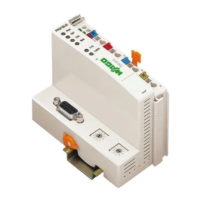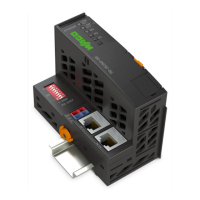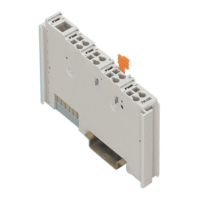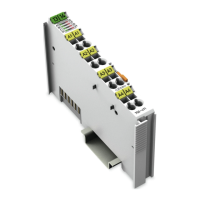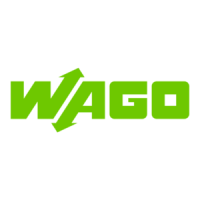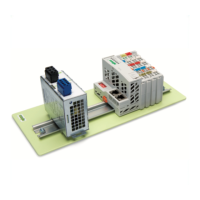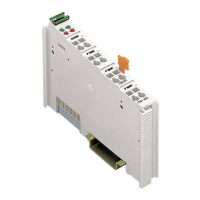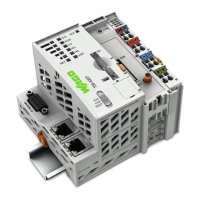Do you have a question about the WAGO 750 Series and is the answer not in the manual?
Covers copyright, personnel qualification, and intended use of the product.
Provides essential safety instructions for handling and operating the device.
Defines the coverage of the manual and lists the item number for the described product.
Lists abbreviations used in the manual for technical terms and components.
Provides an overview of the modular, fieldbus-independent I/O system.
Details the mechanical, electrical, and environmental specifications of the system.
Covers installation position, total expansion, and assembly onto carrier rails.
Explains isolation, system supply, field supply, and fusing requirements.
Details methods for grounding the DIN rail and grounding functions.
Describes the importance and methods of shielding data and signal conductors.
Illustrates and describes the physical components and LEDs of the Linux fieldbus coupler.
Explains the function and meaning of the LEDs on the fieldbus coupler.
Details the initialization process, boot loader, and kernel startup scripts.
Describes how to interpret error codes indicated by the IO LED blink patterns.
Provides detailed system specifications, protocols, and approvals for the coupler.
Lists the directories and files included in the Board Support Package (BSP).
Details the directory structure of the Linux coupler's file system.
Explains how to access and use the console for administration and scripting.
Covers services like Telnet, FTP, Web Server, SNTP, and Netflash.
Guides through installing the necessary toolchain for application development.
Explains the process of compiling the Linux kernel and user space applications.
Covers essential PC software and tools for development and communication.
Details methods for assigning static or dynamic IP addresses.
Provides an introduction to debugging using GDB and DDD.
Explains the fundamental structure and recognition of I/O modules in the process image.
Details the functions and usage of the internal bus driver for module communication.
Describes how to analyze process image data using the /proc directory.
Lists available I/O modules and directs to further documentation.
Details various types of digital input modules and their specifications.
Details various types of digital output modules and their specifications.
Details various types of analog input modules and their specifications.
Details various types of analog output modules and their specifications.
Describes specialized I/O modules like counters, encoders, and serial interfaces.
Explains the process data mapping for modules using MODBUS/TCP.
Demonstrates accessing and controlling the LEDs on the Linux fieldbus coupler.
Shows how to read input modules and set output bits using the internal bus.
Illustrates implementing a Modbus TCP server for reading inputs and setting outputs.
Demonstrates using CGI scripts for web-based management of the coupler.
Shows how to access and manipulate data in the NVRAM.
Guides on installing the special toolchain required for U-Boot development.
Details the setup required for a TFTP server for kernel and file system updates.
Explains relevant environment variables for boot process control and software updates.
Provides a general overview of ETHERNET technology in industrial communication.
Describes the basic principles and regulations of ETHERNET network architecture.
Explains star and tree topologies for ETHERNET networks.
Details general ETHERNET transmission standards and cable types.
Outlines important communication protocols used in WAGO ETHERNET systems.
Explains the Internet Protocol, IP addresses, and network classes.
Covers dynamic IP configuration using DHCP servers.
Details the FTP protocol for file exchange and supported commands.
Lists fieldbus-specific application protocols supported by WAGO couplers.
Covers classifications, zones, explosion groups, and temperature classes per European standards.
Explains different types of ignition protection measures for electrical components.
Details classifications according to NEC 500 for North American hazardous areas.
Provides national installation regulations for explosive areas in Germany, USA, and Canada.
Dynamic Host Configuration Protocol for automatic network configuration.
Specifies a Local Area Network (LAN) and its access method.
Internet Protocol for connectionless network layer communication.
Transport Control Protocol for reliable, connection-oriented data transport.
| Protection Class | IP20 |
|---|---|
| Bus Couplers | PROFIBUS, CANopen, Ethernet |
| Modules | Digital Input, Digital Output, Analog Input, Analog Output |
| Mounting | DIN rail mounting |
| Voltage Supply | 24 V DC (typical) |
| Communication Protocol | Depends on the bus coupler (e.g., PROFIBUS, CANopen, DeviceNet, Ethernet) |
| Digital Input Channels | Varies by module (e.g., 8, 16 channels) |
| Digital Output Channels | Varies by module (e.g., 8, 16 channels) |
| Analog Input Channels | Varies by module (e.g., 2, 4, 8 channels) |
| Analog Output Channels | 1, 2, 4 channels (depending on module) |
| Width | 12 mm, 24 mm (typical module widths) |
| Number of Channels | Varies by module type |
| Current Consumption per Channel | Varies by module type |



